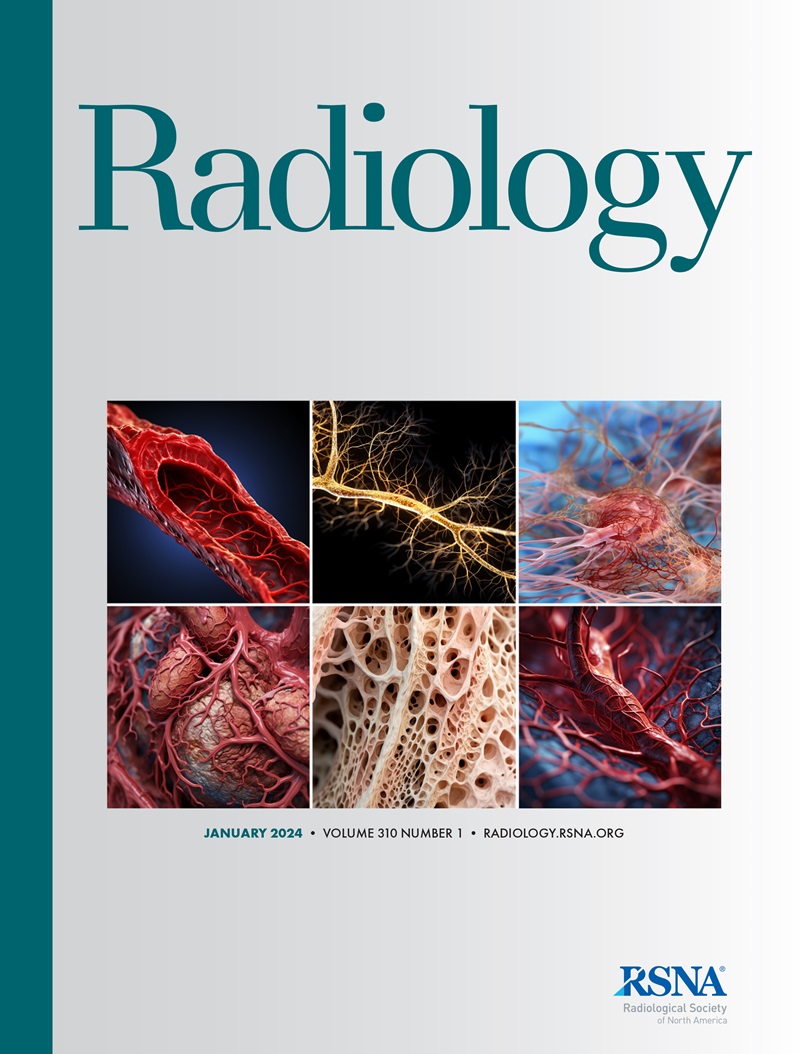Isabel L Langenbach, Ibrahim Hadzic, Roman Zeleznik, Marcel C Langenbach, David Maintz, Thomas Mayrhofer, Michael T Lu, Hugo J W L Aerts, Borek Foldyna
下载PDF
{"title":"Association of Epicardial Adipose Tissue Changes on Serial Chest CT Scans with Mortality: Insights from the National Lung Screening Trial.","authors":"Isabel L Langenbach, Ibrahim Hadzic, Roman Zeleznik, Marcel C Langenbach, David Maintz, Thomas Mayrhofer, Michael T Lu, Hugo J W L Aerts, Borek Foldyna","doi":"10.1148/radiol.240473","DOIUrl":null,"url":null,"abstract":"<p><p>Background Individuals eligible for lung cancer screening with low-dose CT face a higher cardiovascular mortality risk. Purpose To investigate the association between changes in epicardial adipose tissue (EAT) at the 2-year interval and mortality in individuals undergoing serial low-dose CT lung cancer screening. Materials and Methods This secondary analysis of the National Lung Screening Trial obtained EAT volume and density from serial low-dose CT scans using a validated automated deep learning algorithm. EAT volume and density changes over 2 years were categorized into typical (decrease of 7% to increase of 11% and decrease of 3% to increase of 2%, respectively) and atypical (increase or decrease beyond typical) changes, which were associated with all-cause, cardiovascular, and lung cancer mortality. Uni- and multivariable Cox proportional hazard regression models-adjusted for baseline EAT values, age, sex, race, ethnicity, smoking, pack-years, heart disease or myocardial infarction, stroke, hypertension, diabetes, education status, body mass index, and coronary artery calcium-were performed. Results Among 20 661 participants (mean age, 61.4 years ± 5.0 [SD]; 12 237 male [59.2%]), 3483 (16.9%) died over a median follow-up of 10.4 years (IQR, 9.9-10.8 years) (cardiovascular related: 816 [23.4%]; lung cancer related: 705 [20.2%]). Mean EAT volume increased (2.5 cm<sup>3</sup>/m<sup>2</sup> ± 11.0) and density decreased (decrease of 0.5 HU ± 3.0) over 2 years. Atypical changes in EAT volume were independent predictors of all-cause mortality (atypical increase: hazard ratio [HR], 1.15 [95% CI: 1.06, 1.25] [<i>P</i> < .001]; atypical decrease: HR, 1.34 [95% CI: 1.23, 1.46] [<i>P</i> < .001]). An atypical decrease in EAT volume was associated with cardiovascular mortality (HR, 1.27 [95% CI: 1.06, 1.51]; <i>P</i> = .009). EAT density increase was associated with all-cause, cardiovascular, and lung cancer mortality (HR, 1.29 [95% CI: 1.18, 1.40] [<i>P</i> < .001]; HR, 1.29 [95% CI: 1.08, 1.54] [<i>P</i> = .005]; HR, 1.30 [95% CI: 1.07, 1.57] [<i>P</i> = .007], respectively). Conclusion EAT volume increase and decrease and EAT density increase beyond typical on subsequent chest CT scans were associated with all-cause mortality in participants screened for lung cancer. EAT volume decrease and EAT density increase were associated with elevated risk of cardiovascular mortality after adjustment for baseline EAT values. © RSNA, 2025 <i>Supplemental material is available for this article.</i> See also the editorial by Fuss in this issue.</p>","PeriodicalId":20896,"journal":{"name":"Radiology","volume":"314 2","pages":"e240473"},"PeriodicalIF":12.1000,"publicationDate":"2025-02-01","publicationTypes":"Journal Article","fieldsOfStudy":null,"isOpenAccess":false,"openAccessPdf":"https://www.ncbi.nlm.nih.gov/pmc/articles/PMC11868846/pdf/","citationCount":"0","resultStr":null,"platform":"Semanticscholar","paperid":null,"PeriodicalName":"Radiology","FirstCategoryId":"3","ListUrlMain":"https://doi.org/10.1148/radiol.240473","RegionNum":1,"RegionCategory":"医学","ArticlePicture":[],"TitleCN":null,"AbstractTextCN":null,"PMCID":null,"EPubDate":"","PubModel":"","JCR":"Q1","JCRName":"RADIOLOGY, NUCLEAR MEDICINE & MEDICAL IMAGING","Score":null,"Total":0}
引用次数: 0
引用
批量引用
Abstract
Background Individuals eligible for lung cancer screening with low-dose CT face a higher cardiovascular mortality risk. Purpose To investigate the association between changes in epicardial adipose tissue (EAT) at the 2-year interval and mortality in individuals undergoing serial low-dose CT lung cancer screening. Materials and Methods This secondary analysis of the National Lung Screening Trial obtained EAT volume and density from serial low-dose CT scans using a validated automated deep learning algorithm. EAT volume and density changes over 2 years were categorized into typical (decrease of 7% to increase of 11% and decrease of 3% to increase of 2%, respectively) and atypical (increase or decrease beyond typical) changes, which were associated with all-cause, cardiovascular, and lung cancer mortality. Uni- and multivariable Cox proportional hazard regression models-adjusted for baseline EAT values, age, sex, race, ethnicity, smoking, pack-years, heart disease or myocardial infarction, stroke, hypertension, diabetes, education status, body mass index, and coronary artery calcium-were performed. Results Among 20 661 participants (mean age, 61.4 years ± 5.0 [SD]; 12 237 male [59.2%]), 3483 (16.9%) died over a median follow-up of 10.4 years (IQR, 9.9-10.8 years) (cardiovascular related: 816 [23.4%]; lung cancer related: 705 [20.2%]). Mean EAT volume increased (2.5 cm3 /m2 ± 11.0) and density decreased (decrease of 0.5 HU ± 3.0) over 2 years. Atypical changes in EAT volume were independent predictors of all-cause mortality (atypical increase: hazard ratio [HR], 1.15 [95% CI: 1.06, 1.25] [P < .001]; atypical decrease: HR, 1.34 [95% CI: 1.23, 1.46] [P < .001]). An atypical decrease in EAT volume was associated with cardiovascular mortality (HR, 1.27 [95% CI: 1.06, 1.51]; P = .009). EAT density increase was associated with all-cause, cardiovascular, and lung cancer mortality (HR, 1.29 [95% CI: 1.18, 1.40] [P < .001]; HR, 1.29 [95% CI: 1.08, 1.54] [P = .005]; HR, 1.30 [95% CI: 1.07, 1.57] [P = .007], respectively). Conclusion EAT volume increase and decrease and EAT density increase beyond typical on subsequent chest CT scans were associated with all-cause mortality in participants screened for lung cancer. EAT volume decrease and EAT density increase were associated with elevated risk of cardiovascular mortality after adjustment for baseline EAT values. © RSNA, 2025 Supplemental material is available for this article. See also the editorial by Fuss in this issue.

 求助内容:
求助内容: 应助结果提醒方式:
应助结果提醒方式:


